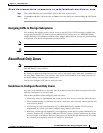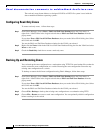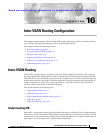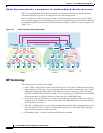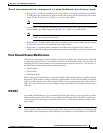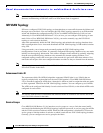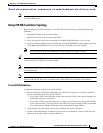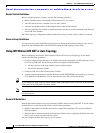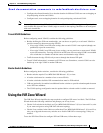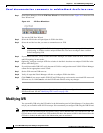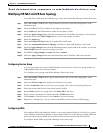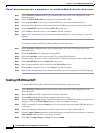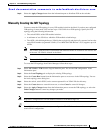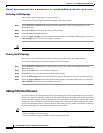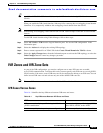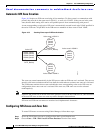
Send documentation comments to mdsfeedback-doc@cisco.com.
16-7
Cisco MDS 9000 Family Fabric Manager Configuration Guide
OL-6965-03, Cisco MDS SAN-OS Release 2.x
Chapter 16 Inter-VSAN Routing Configuration
Using the IVR Zone Wizard
• Configure the allowed-domains list so that the domains in different VSANs are non-overlapping on
all participating switches and VSANs.
• Configure static, non-overlapping domains for each participating switch and VSAN.
Note In a configuration involving IVR without NAT, if one VSAN in the IVR topology is configured with
static domain IDs, then the other VSANs (edge or transit) in the topology should has to be configured
with static domain IDs.
Transit VSAN Guidelines
Before configuring transit VSANS, consider the following guidelines:
• Besides defining the IVR zone membership, you can choose to specify a set of transit VSANs to
provide connectivity between two edge VSANs:
–
If two edge VSANs in an IVR zone overlap, then a transit VSAN is not required (though, not
prohibited) to provide connectivity.
–
If two edge VSANs in an IVR zone do not overlap, you may need one or more transit VSANs
to provide connectivity. Two edge VSANs in an IVR zone will not overlap if IVR is not enabled
on a switch that is a member of both the source and destination edge VSANs.
• Traffic between the edge VSANs only traverses through the shortest IVR path.
• Transit VSAN information is common to all IVR zone sets. Sometimes, a transit VSAN can also
double-up as an edge VSAN in another IVR zone.
Border Switch Guidelines
Before configuring border switches, consider the following guidelines:
• Border switches require Cisco MDS SAN-OS Release 1.3(1) or later.
• A border switch must be a member of two or more VSANs.
• A border switch that facilities IVR communications must be IVR enabled.
• IVR can (optionally) be enabled on additional border switches to provide redundant paths between
active IVR zone members.
• The VSAN topology configuration must be updated before a border switch is added or removed.
Using the IVR Zone Wizard
The IVR Zone Wizard simplifies the steps required to configure IVR zones in a fabric. The IVR Zone
Wizard checks the following conditions and prompts you for any issues:
• Checks if all switches in the fabric are Cisco MDS SAN-OS Release 2.1(1a) or later and if so, asks
if you want to migrate to using IVR NAT with auto-topology.
• Checks if any switches in the fabric are earlier than Cisco MDS SAN-OS Release 2.1(1a) and if so,
asks you to upgrade the necessary switches or to disable IVR NAT or auto-topology if they are
enabled.
To use the IVR Zone Wizard to configure IVR and IVR zones, follow these steps:



